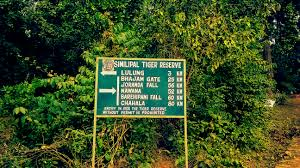National Park Status for Similipal: Gold Filling in a Decaying Mouth?

The Similipal Biosphere Reserve in Odisha was accorded the status of a National Park recently (April 24). This may have come quite late in the day, nevertheless, it at last grants Simlipal added notional security ring as regards its health, mainly due to humongous human pressure and a long phase of neglect by the state forest department.
On Thursday, April 24, 2025, the Odisha government notified the Similipal Tiger Reserve (STR), the world's only home to wild melanistic tigers (they have darker coat due to increased melanin production), as a ‘National Park’ spanning an area of 845.70 sq/km. It is the 107th National Park in the country and the second in the eastern state, after the Bhitarkanika National Park in Kendrapara district.
Before that, the ever-deteriorating health of the Similipal Biosphere Reserve was a continuous challenge for the wildlife authorities here.
Be it the forest or the flora and fauna, this magnificent mountainous stretch connecting with the Meghasan Hills, which is viewed as a primary regime that controls the North monsoon, now requires a closer look for redressal.
Four Decades of Wait
Proposed as a National Park way back in 1980, the Similipal Biosphere Reserve had to wait for over four decades to get the status. But will this really ameliorate the failing health of this once magnificent wildlife treasure?
Experts who have studied the area for a long time, hold a different view.
“The National Park status gives only legal recognition, nothing beyond that”, Biswajit Mohanty, an environment activist who has studied Similipal for long, told this writer.
“Similipal was already being protected when it was a proposed National Park and a Wildlife Sanctuary but it did not have the legal tag of a National Park” he added.

After announcing the notification, Chief Minister Mohan Charan Majhi said, “The long-awaited declaration strengthens our ecological legacy, uplifts tribal aspirations and reaffirms Odisha’s commitment to sustainable development.”
The biosphere reserve is spread over 4,374 sq. km. and has 845 sq. km. of core forest (tiger reserve), 2,129 sq km of buffer area and 1,400 sq km of transition space. It is located in Mayurbhanj district of Odisha.
Issues of Concern
However, only the core area has been declared as a National Park. The buffer zone continues to be a Wildlife Sanctuary.
“Both the areas are together. But protection of tigers, elephants and other wildlife species has never been done seriously by state governments in the past many years,” said Mohanty.
Similipal stands out for its tiger population that exhibits ‘melanism’ , which is on the wane in the past few years, rather, there has been an alarming drop in numbers leading to growing concern in the wildlife regime.
Taking an apparent swipe at the project authorities, Mohanty said according to a census by the National Tiger Conservation Authority (NTCA), the tiger population dropped from 101 to about 55 in 2007.
Whereas, sources in the wildlife department in Similipal would have us believe that the tiger population has plunged to just 16, which is a cause of grave concern.
“Tribal poachers routinely enter the park to hunt animals in which even tigers fall victim”, claimed Mohanty, adding that “forest fires also play havoc and there is no effort by the forest staff to motivate the locals to be a part of the conservation”.
In fact, villagers or mainly from the tribal community, can play a significant role in the control of forest fires that often prove menacing for all species, he added.
Thousands of forest dwellers depend upon non-timber forest produce for their survival and income. “There is an active timber mafia that daily smuggles out timber, which is not possible without the direct or indirect support of the locals” Mohanty said.
So, community participation is a major tool against all such problems besides the deployment of a task force.
“Though armed guards have been deployed since the past two years, Similipal needs a more broad-based approach and community participation for protection”, said Mohanty.
It is mostly seen that the role of inhabitants is crucial for conservation.

The flip side of what Mohanty observed is that “right now, that bridge does not exist. Local communities do not view the park as something to be treasured and protected since there is no gain for them”.
Alternative Measures
This can only change if the government initiates a widespread campaign and takes steps to improve the livelihoods of local communities through various avenues. There is a view that eco-tourism could be a big opportunity, provided it is totally community managed and the benefits flow to them.
But any approach should be holistic not leading to excessive inflow of tourists and construction of roads tearing through the irreplaceable forest covers, say some experts.
Imagine the pressure when there are about 62 villages within the core area in addition to the small villages in other areas, which comes to about 1,200 villages, with roughly a majority of them dependent on the forests for livelihood.
The writer is a freelancer based in Odisha.
Get the latest reports & analysis with people's perspective on Protests, movements & deep analytical videos, discussions of the current affairs in your Telegram app. Subscribe to NewsClick's Telegram channel & get Real-Time updates on stories, as they get published on our website.
























